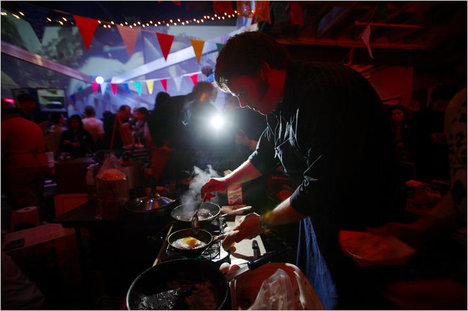Source of book image:
http://portland.readinglocal.com/files/2011/09/mann-1493.jpg
(p. D2) The foods we consider local are results of a globalization process that has been in full swing for more than five centuries, ever since Columbus landed in the New World. Suddenly all the continents were linked, mixing plants and animals that had evolved separately since the breakup of the ancient supercontinent Pangaea.
What resulted, Mr. Mann argues in his fascinating new book, “1493: Uncovering the New World Columbus Created,” was a new epoch in human life, the Homogenocene. This age of homogeneity was brought on by the creation of a world-spanning economic system as crops, worms, parasites and people traveled among Europe, the Americas, Africa and Asia — the Columbian Exchange, as it was dubbed by the geographer Alfred W. Crosby.
. . .
“There’s no way the Industrial Revolution could have so occurred so quickly and so widely if the world had depended solely on Brazilians tapping rubber trees,” Mr. Mann said. Indeed, the Asian plantations proved crucial when Brazilian trees were struck by blight.
“On the whole, there are lots more winners than losers from the Columbian Exchange,” Mr. Mann said. “I don’t want to tell Italians they can’t have tomatoes, or people in Sichuan they can’t have peppers. People have a way of taking things and making them their own. I know nothing in my garden is native, but I still have this idiotic feeling that it’s my home.”
How does he reconcile this feeling with this book? What’s a locavore to do? Mr. Mann doesn’t presume to dictate anyone’s food preferences, but he does offer one piece of advice for locavores: go easy on the preaching.
“I’m willing to pay more to get fresh vegetables grown by nice people farming nearby,” he said. “It’s incredible to eat lettuce an hour after it was picked.
“But if your concern is to produce the maximum amount of food possible for the lowest cost, which is a serious concern around the world for people who aren’t middle-class foodies like me, this seems like a crazy luxury. It doesn’t make sense for my aesthetic preference to be elevated to a moral imperative.”
For the full review, see:
JOHN TIERNEY. “FINDINGS; Fresh and Direct From the Garden an Ocean Away.” The New York Times (Tues., August 30, 2011): D2.
(Note: ellipsis added.)
(Note: the online version of the article is dated August 29, 2011.)





